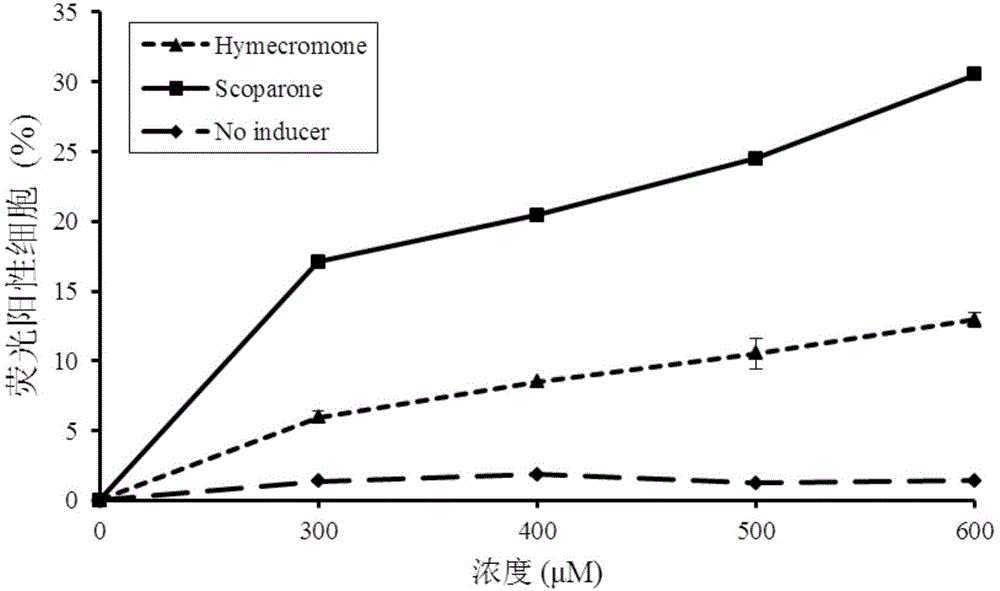Applications of coumarin compounds in preparing HIV-latency-resisting treatment medicine
A technology for coumarins and therapeutic drugs, which is applied in the field of medicine to achieve the effects of low cytotoxicity and accelerated clearance
- Summary
- Abstract
- Description
- Claims
- Application Information
AI Technical Summary
Problems solved by technology
Method used
Image
Examples
Embodiment 1
[0042] The effect concentration of embodiment 1.Hymecromone and Scoparone compound is on the influence of HIV latent induction activation efficiency
[0043] C11 cells were planted in a 96-well plate at 2×10E4 cells per well, and 100ul of 1640 medium (Gibco) containing 10% FBS (Gibco) was added to each well. After 24 hours, Hymecromone and Scoparone of different concentrations were added to make the final The concentrations are 0 μM, 300 μM, 400 μM, 500 μM, 600 μM, respectively. At least 3 replicate wells for each concentration, and each experiment was repeated 3 times. After the cells were treated with drugs for 72 hours, the expression of GFP in the cells was observed under a fluorescence microscope, and the cells were collected for flow cytometry detection, and the proportion of fluorescent cells was analyzed;
[0044] The results showed that with the increase of the compound concentration of Hymecromone and Scoparone, the number of cells expressing green fluorescence in th...
Embodiment 2
[0045] Embodiment 2.The effect of the action time of Hymecromone and Scoparone compounds on the efficiency of HIV latent induction and activation
[0046] 2 × 10E4 C11 cells were planted in a 96-well plate per well, and 100ul of 1640 medium (Gibco) containing 10% FBS (Gibco) was added to each well. After 24 hours, Hymecromone and Scoparone were added with a final concentration of 500 μM. After treating the cells for 24h, 48h, 72h, and 96h, observe the expression of GFP in the cells under a fluorescent microscope, and collect the cells for flow cytometry detection to analyze the proportion of fluorescent cells. At least 3 replicate wells at each time point, each Each experiment was repeated 3 times, and the kinetic characteristics of induced activation were analyzed and compared;
[0047] The results showed that when Hymecromone and Scoparone respectively treated the HIV latent infection cell model, the number of green fluorescent positive cells gradually increased with the ext...
Embodiment 3
[0048] Example 3. Hymecromone and Scoparone Toxic Effects on Cells
[0049] 2×10E4 normal human peripheral blood mononuclear cells (PBMC) were planted in a 96-well plate, and 100ul of DMEM medium (Gibco) containing 10% FBS (Gibco) was added to each well. After 24 hours, different concentrations were added Hymecromone and Scoparone, so that the final concentrations were 0 μM, 100 μM, 500 μM, 1000 μM, 2500 μM, 5000 μM, each concentration was at least 3 replicate wells, and each experiment was repeated 3 times. After drug treatment of cells for 72 hours, add MTT reagent (0.5mg / mL) (purchased from SIGMA), shake for 1h, measure the OD value at 570nm on the microplate reader;
[0050]The results showed that the half toxic concentration of Hymecromone and Scoparone to human normal cells were CC50=2100μM and CC50=2400μM respectively. The results showed that the toxicity of Hymecromone and Scoparone was lower at the activation concentration, which laid the foundation for clinical appli...
PUM
 Login to View More
Login to View More Abstract
Description
Claims
Application Information
 Login to View More
Login to View More - R&D
- Intellectual Property
- Life Sciences
- Materials
- Tech Scout
- Unparalleled Data Quality
- Higher Quality Content
- 60% Fewer Hallucinations
Browse by: Latest US Patents, China's latest patents, Technical Efficacy Thesaurus, Application Domain, Technology Topic, Popular Technical Reports.
© 2025 PatSnap. All rights reserved.Legal|Privacy policy|Modern Slavery Act Transparency Statement|Sitemap|About US| Contact US: help@patsnap.com



